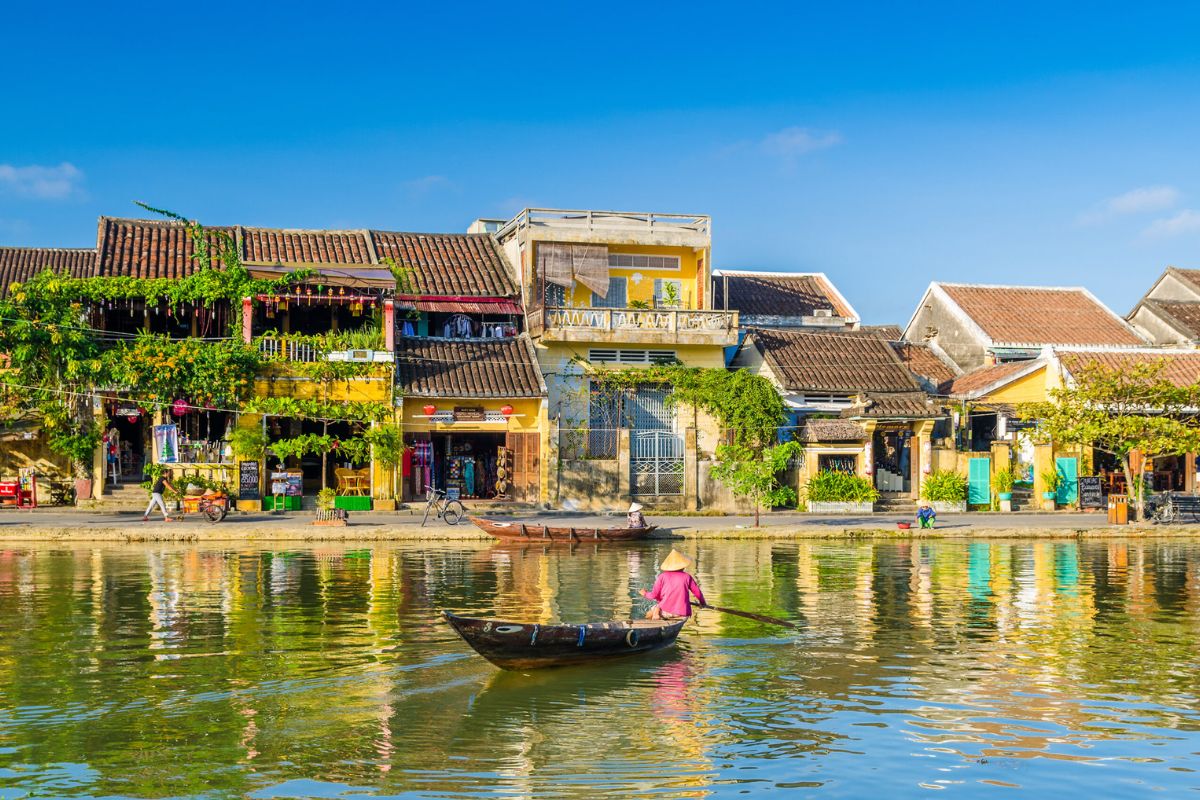TABLE OF CONTENT
Nestled in the lush Vietnamese countryside, the Cu Chi Tunnels serve as a testament to the resilience and ingenuity of Vietnamese people during the Vietnam War. In this comprehensive guide, Asia Encounter will take you on a journey through the Cu Chi Tunnels tour from Ho Chi Minh city, providing insights, tips, and everything you need to make the most of your tour.

Understanding the history of Cu Chi Tunnels
Before embarking on your Cu Chi Tunnels tour from Ho Chi Minh, it’s crucial to understand the historical context. This intricate underground network played a crucial role in the tactics employed by the Viet Cong against the better-equipped and technologically superior American and South Vietnamese forces.
Pre-War Origins
The construction of the Cu Chi Tunnels began during the late 1940s, preceding the Vietnam War. Initially created as a means of resistance against French colonial rule, the tunnels were expanded and refined over the years. By the time the Vietnam War (1955-1975) escalated, the Cu Chi Tunnels had evolved into an extensive and sophisticated underground network.
Strategic Significance
During the Vietnam War, the Cu Chi Tunnels served as a crucial component of the Ho Chi Minh Trail, a network of supply routes that spanned across Cambodia, Laos, and North Vietnam. This trail allowed the North Vietnamese forces to transport troops, supplies, and weapons to the Viet Cong in South Vietnam, supporting their insurgency against the American-backed South Vietnamese government.
The Cu Chi Tunnels were strategically located near the Cu Chi district, an area of immense importance due to its proximity to Saigon, the capital of South Vietnam. The tunnels provided the Viet Cong with a hidden base from which they could launch surprise attacks, infiltrate enemy lines, and disappear swiftly.
Role in the War
The Cu Chi Tunnels served a crucial role in the overall strategy of the Viet Cong. The ability to disappear underground allowed them to evade the superior firepower of the American and South Vietnamese forces. The tunnels served as a hiding place during air raids, a secure communication network, and a base for launching surprise attacks.
American forces, aware of the tunnels’ significance, launched extensive efforts to locate and destroy them. However, the Viet Cong’s resilience and familiarity with the terrain enabled them to withstand these assaults, making the Cu Chi Tunnels a symbol of their determination and tactical understanding.
>> Explore more: Vietnam War Tour Ho Chi Minh City: 5 Best Places Worth Visiting
Cu Chi Tunnels’ design and construction
The Cu Chi Tunnels were a marvel of engineering and resourcefulness. The underground network stretched over 120 miles, featuring a complex system of tunnels, bunkers, living quarters, storage facilities, and even hospitals. The tunnels were constructed using simple tools like shovels and pickaxes, and the soil extracted during the digging was discreetly dispersed in nearby fields to avoid detection.
The tunnels had multiple levels, with some reaching depths of 30 feet or more. Narrow passageways connected various chambers, and trapdoors and secret entrances allowed the Viet Cong to enter and exit undetected. Ventilation shafts disguised as termite mounds ensured a supply of air, and ingenious booby traps were strategically placed to thwart any attempts by the enemy to infiltrate the tunnels.
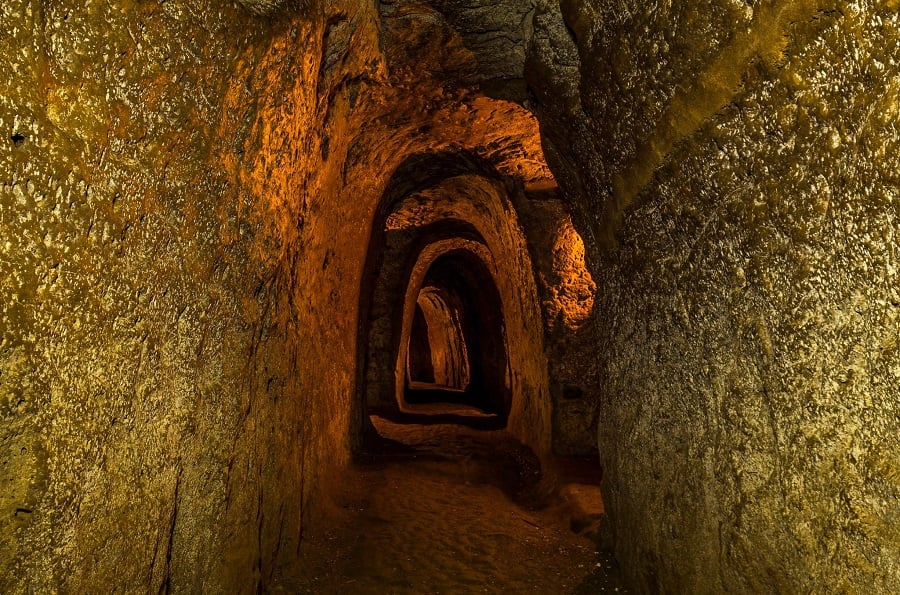
The layers of Cu Chi tunnels:
- Underground Network:Stretching over 120 miles, these tunnels, the primary architectural feature of the Cu Chi Tunnels, formed a complex labyrinth that allowed the Viet Cong to move stealthily beneath the surface.
- Multiple Levels:Reaching depths of 30 feet or more, the inclusion of multiple levels served various purposes, including providing additional hiding spaces and complicating enemy attempts to locate and destroy the tunnels.
- Narrow Passageways:The tunnels featured narrow passageways, typically designed to accommodate only one person at a time. This deliberate choice made it challenging for enemy soldiers to navigate the tunnels.
- Camouflaged Entrances: Trapdoors were hidden under leaves, and openings were concealed in natural surroundings, making it difficult for enemy forces to identify and access these entry points.
- Trap Systems: These traps were strategically placed to thwart enemy soldiers attempting to infiltrate the tunnel network.
- Ventilation Systems: Ingeniously disguised as termite mounds or hidden in the natural environment, these ventilation shafts allowed for the exchange of air within the tunnels.
- Command Centers:These spaces were strategically located to facilitate communication and decision-making among Viet Cong leaders.
- Living Quarters: These areas featured basic amenities such as sleeping spaces, kitchen facilities, and storage.
- Storage Facilities:Storage facilities were integrated into the tunnel architecture to secure supplies, weapons, and equipment.
Life in Cu Chi tunnels

When exploring the Cu Chi Tunnels tour from Ho Chi Minh, you will see that the living conditions here are incredibly cramped. The narrow tunnels limited movement, and the lack of proper ventilation and sanitation posed serious challenges. Despite these hardships, the Viet Cong adapted to their underground existence, establishing kitchens, meeting rooms, and medical facilities.
The tunnels provided a refuge where they could rest, plan operations, and seek protection from the relentless bombings and ground offensives.
>> You can also explore more of the beauty of Vietnamese history at museums in Ho Chi Minh city
Must-try experiences in Cu Chi tunnels
As you explore this remarkable site, several signature experiences await, providing insights into the lives of the Viet Cong and their ingenious tactics during the Vietnam War. Here are some signature experiences that make a visit to the Cu Chi Tunnels unforgettable:
1. Crawling through the tunnels
 |
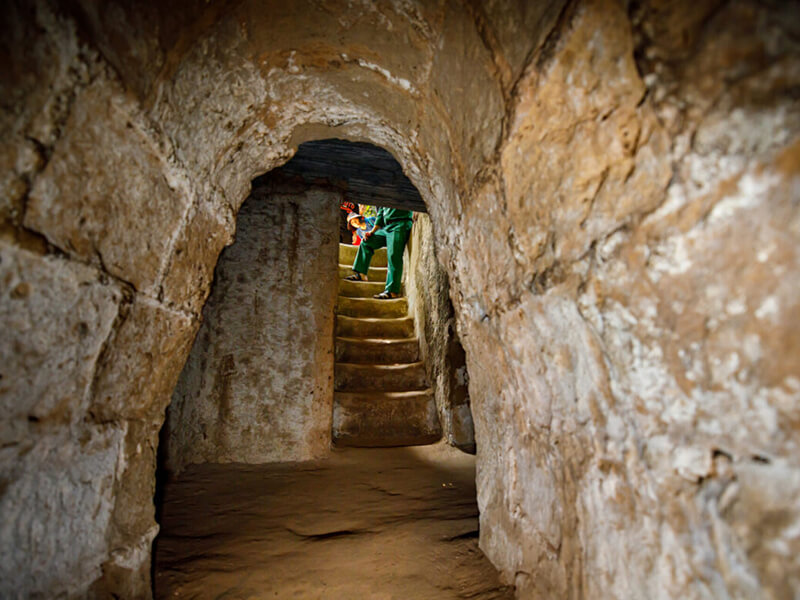 |
Perhaps the most iconic and immersive experience at the Cu Chi Tunnels is crawling through the narrow passages. Visitors have the opportunity to descend into the underground world, navigating through the same tunnels used by the Viet Cong. This firsthand experience offers a visceral understanding of the challenges faced by those who lived and fought in this subterranean environment.
Discover the hidden trapdoors and entrances strategically camouflaged amidst the natural surroundings. Guides often demonstrate the stealthy techniques used by the Viet Cong to conceal entry points, adding an element of intrigue to the exploration.
3. Witnessing ingenious trap systems
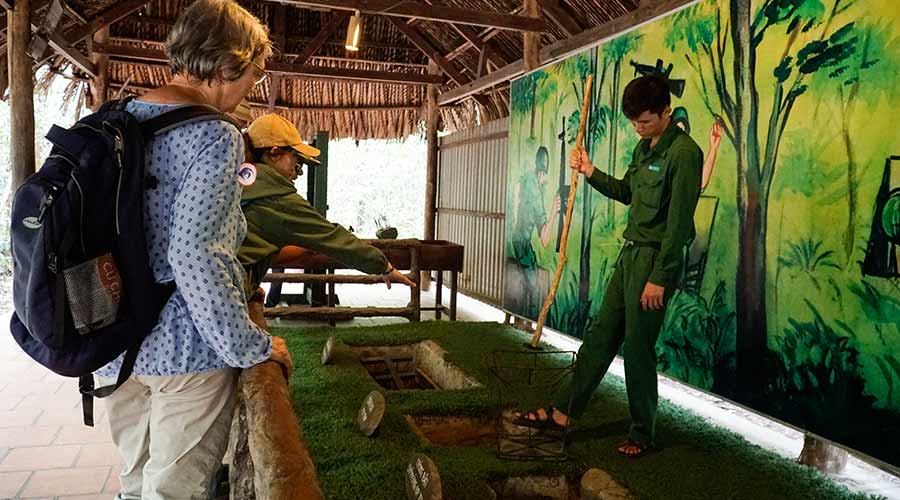
Gain insight into the Viet Cong’s tactical brilliance by observing demonstrations of the various trap systems scattered throughout the Cu Chi Tunnels. Guides showcase the functioning of traps like spike pits and concealed holes, emphasizing the resourcefulness employed to defend the tunnel network.
4. Engaging with educational presentations
Take advantage of educational presentations provided by knowledgeable guides. These presentations offer historical context, personal stories, and in-depth insights into the strategic importance of the Cu Chi Tunnels during the Vietnam War.
5. Participating in Shooting Range Activities
For those seeking a unique experience, some tour operators offer shooting range activities where visitors can fire historic weapons used during the war. This optional activity provides a hands-on understanding of the firearms utilized by both sides during the conflict.
>> Discover more Ho Chi Minh tours HERE!
6. Touring Historical Exhibits
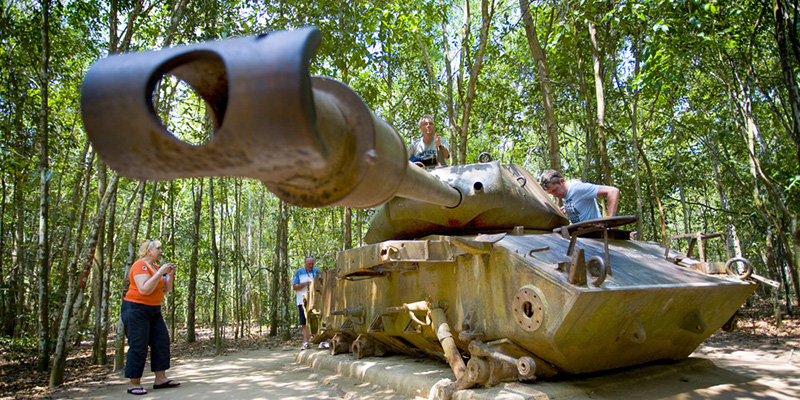
In addition to exploring the tunnels, the Cu Chi Tunnels site features informative exhibits and displays. These exhibits provide a comprehensive overview of the Vietnam War, showcasing weapons, traps, and tools used by the Viet Cong. Take your time to absorb the historical artifacts and gain a broader perspective on the conflict and its impact on the Vietnamese people.
7. Reflecting at Memorial and Remembrance Areas
Take a moment for reflection at the memorial areas dedicated to those who fought and sacrificed during the Vietnam War. Statues, plaques, and symbolic elements offer a space for visitors to pay their respects and connect on a deeper level with the historical significance of the site.
Tour & transportation options for Cu Chi tunnels
When planning your Cu Chi Tunnels tour from Ho Chi Minh City, you’ll find various options to suit your preferences. Most tours offer a combination of transportation, guided tours, and sometimes additional stops at other historical or cultural sites.
Whether you choose a group tour or a private experience, consider your schedule, interests, and budget to find the best fit.
>> Explore more: Vietnam Travel Guide – What To Know Before Your Journey
1. Guided Tours
Pros: A guided tour is essential to fully comprehend the historical significance of the Cu Chi Tunnels. Knowledgeable guides will lead you through the maze of tunnels, providing insights into the strategies employed by the Viet Cong and the challenges they face. Take the time to listen to personal stories and gain a deeper understanding of the resilience displayed by the Vietnamese people during a tumultuous period in their history.
Cons: The quality of guided tours can be various, so it’s essential to research and choose a reputable operator.
2. Bus Tours
Pros: Bus tours are a popular and cost-effective option for visiting the Cu Chi Tunnels. Many tour operators based in Ho Chi Minh City provide air-conditioned buses that offer a comfortable and hassle-free journey.
Cons: Bus tours may have fixed schedules and limited flexibility. The large group size might result in less personalized attention from the tour guide.
3. Motorbike Tours
Pros: For the adventurous traveler, Ho Chi Minh motorbike tours offer a unique and exhilarating experience. Riding through the scenic Vietnamese countryside provides a different perspective on the journey.
Cons: Motorbike tours are not suitable for everyone, especially those who are not comfortable riding on two wheels. Safety considerations should be a top priority.
4. Boat Tours
Pros: Some tour operators offer boat tours that take you to the Cu Chi Tunnels via the Saigon River. This option adds an element of adventure and scenic beauty to your journey.
Cons: Boat tours may have limited availability, and the travel time might be longer compared to other transportation options.
5. Bicycle Tours
Pros: Bicycle tours provide a unique and eco-friendly way to reach the Cu Chi Tunnels. This option is suitable for those who enjoy outdoor activities and want a more immersive experience.
Cons: The distance and traffic conditions may make this option challenging for some individuals. It requires a good level of physical fitness.
Notes for taking Cu Chi tunnels tour
Respecting the site
As you explore the Cu Chi Tunnels, it’s crucial to show respect for the historical significance of the site. Follow the guidance of your tour guide, stay on designated paths, and avoid touching any artifacts or structures. Remember that this site holds deep cultural and emotional importance for the Vietnamese people, and your visit should be a respectful and educational experience.
What to pack for Cu Chi tunnels tour
- Hydration: Bring water to stay hydrated during your exploration, especially if you visit during the warmer months.
- Sun Protection: Apply sunscreen along the trip and wear a hat to protect yourself from the sun.
- Photography: Capture the memories, but be mindful of where you’re allowed to take photos.
- Comfortable Clothing: Wear lightweight, breathable clothing suitable for crawling through tunnels.
—-
A journey to the Cu Chi Tunnels is a powerful and educational experience that allows you to step back in time and witness the resilience of the Vietnamese people. Embark on a captivating journey with Asia Encounter as you delve into the historical depths of the Cu Chi Tunnels on a private tour.
With personalized attention and the expertise of knowledgeable guides, this exclusive experience offers a deeper understanding of the ingenious tactics employed by the Viet Cong during the Vietnam War. We ensures a seamless and immersive adventure, allowing you to absorb the rich history of the Cu Chi Tunnels at your own pace, making it a truly memorable and insightful exploration.


